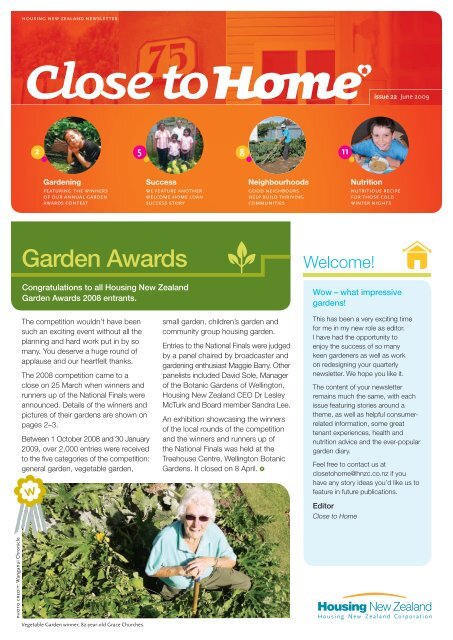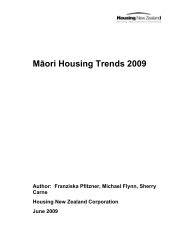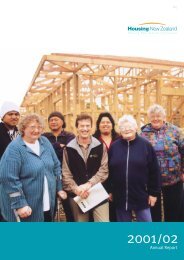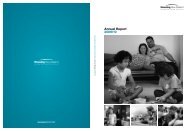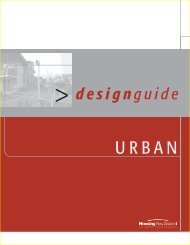Close to Home: Issue 22, June 2009 - Housing New Zealand
Close to Home: Issue 22, June 2009 - Housing New Zealand
Close to Home: Issue 22, June 2009 - Housing New Zealand
You also want an ePaper? Increase the reach of your titles
YUMPU automatically turns print PDFs into web optimized ePapers that Google loves.
housing new zealand newsletter<br />
issue <strong>22</strong> <strong>June</strong> <strong>2009</strong><br />
2<br />
5 8 11<br />
Gardening<br />
featuring the winners<br />
of our annual garden<br />
awards contest<br />
Success<br />
we feature another<br />
welcome home loan<br />
success s<strong>to</strong>ry<br />
Neighbourhoods<br />
good neighbours<br />
help build thriving<br />
communities<br />
Nutrition<br />
nutritious recipe<br />
for those cold<br />
winter nights<br />
Garden Awards<br />
Congratulations <strong>to</strong> all <strong>Housing</strong> <strong>New</strong> <strong>Zealand</strong><br />
Garden Awards 2008 entrants.<br />
Welcome!<br />
Wow – what impressive<br />
gardens!<br />
The competition wouldn’t have been<br />
such an exciting event without all the<br />
planning and hard work put in by so<br />
many. You deserve a huge round of<br />
applause and our heartfelt thanks.<br />
The 2008 competition came <strong>to</strong> a<br />
close on 25 March when winners and<br />
runners up of the National Finals were<br />
announced. Details of the winners and<br />
pictures of their gardens are shown on<br />
pages 2–3.<br />
Between 1 Oc<strong>to</strong>ber 2008 and 30 January<br />
<strong>2009</strong>, over 2,000 entries were received<br />
<strong>to</strong> the five categories of the competition:<br />
general garden, vegetable garden,<br />
small garden, children’s garden and<br />
community group housing garden.<br />
Entries <strong>to</strong> the National Finals were judged<br />
by a panel chaired by broadcaster and<br />
gardening enthusiast Maggie Barry. Other<br />
panelists included David Sole, Manager<br />
of the Botanic Gardens of Welling<strong>to</strong>n,<br />
<strong>Housing</strong> <strong>New</strong> <strong>Zealand</strong> CEO Dr Lesley<br />
McTurk and Board member Sandra Lee.<br />
An exhibition showcasing the winners<br />
of the local rounds of the competition<br />
and the winners and runners up of<br />
the National Finals was held at the<br />
Treehouse Centre, Welling<strong>to</strong>n Botanic<br />
Gardens. It closed on 8 April.<br />
This has been a very exciting time<br />
for me in my new role as edi<strong>to</strong>r.<br />
I have had the opportunity <strong>to</strong><br />
enjoy the success of so many<br />
keen gardeners as well as work<br />
on redesigning your quarterly<br />
newsletter. We hope you like it.<br />
The content of your newsletter<br />
remains much the same, with each<br />
issue featuring s<strong>to</strong>ries around a<br />
theme, as well as helpful consumerrelated<br />
information, some great<br />
tenant experiences, health and<br />
nutrition advice and the ever-popular<br />
garden diary.<br />
Feel free <strong>to</strong> contact us at<br />
close<strong>to</strong>home@hnzc.co.nz if you<br />
have any s<strong>to</strong>ry ideas you’d like us <strong>to</strong><br />
feature in future publications.<br />
Edi<strong>to</strong>r<br />
<strong>Close</strong> <strong>to</strong> <strong>Home</strong><br />
pho<strong>to</strong> credit: Wanganui Chronicle<br />
Vegetable Garden winner, 82-year-old Grace Churches.
2<br />
Gardening feature<br />
The winning gardens<br />
General Garden Small Garden Vegetable Garden<br />
Winner<br />
Beverley Hamil<strong>to</strong>n, <strong>New</strong> Plymouth<br />
Joint winner<br />
Arthur and Patricia Hughes, Nelson<br />
Winner<br />
Grace Churches, Wanganui<br />
Runner up<br />
George and Lynette Murphy, Thames<br />
Joint winner<br />
Frank Timmo, Otahuhu, Auckland<br />
Runner up<br />
Daxiong Lu and Chengru Pang,<br />
Takapuna, Auckland<br />
Highly commended<br />
Stanley Hodge, Papa<strong>to</strong>e<strong>to</strong>e, Auckland<br />
Highly commended<br />
Dianne Pihama, Linwood<br />
Highly commended<br />
Latai Tolutau and Vavau Otuafi,<br />
Papakura, Auckland<br />
close <strong>to</strong> home june <strong>2009</strong>
3<br />
Community Group <strong>Housing</strong> Children’s Garden Environmentally Friendly<br />
Winner<br />
Te Roopu Taurima O Manukau Trust,<br />
Kaikohe<br />
Winner<br />
Vic<strong>to</strong>r Joseph Viki, Kels<strong>to</strong>n, Auckland<br />
Winner<br />
Shaun Salmon, North Canterbury<br />
Runner up<br />
Idea Services, Whangarei<br />
The judging<br />
A panel judged entries based on the<br />
pho<strong>to</strong>graphs using a points system,<br />
scoring gardens for effort, quality<br />
and presentation. The panel were<br />
on the lookout for a wide range of<br />
indica<strong>to</strong>rs including tidiness, variety<br />
of plants, use of space, garden<br />
layout and general health of plants.<br />
Category winners from the local<br />
rounds of the competition were<br />
au<strong>to</strong>matically entered for a chance<br />
<strong>to</strong> win at the Garden Awards<br />
National Finals.<br />
Runner up<br />
Oceana and Kristal-Lea Watt, Huntly<br />
National awards<br />
presentation<br />
One hundred and forty gardens from<br />
all categories made it <strong>to</strong> the National<br />
Finals. Winners and runners up<br />
were presented with Garden Awards<br />
certificates and Mitre 10 gift cards<br />
by regional managers. Runners up<br />
in the Community Group <strong>Housing</strong><br />
category, Idea Services in Whangarei,<br />
were presented their certificate<br />
and prize vouchers by the<br />
Minister of <strong>Housing</strong>,<br />
Phil Heatley.<br />
Runner up<br />
Cherri Dougherty-Ward,<br />
Mt Maunganui, Tauranga<br />
IHC resident Eric Strongman gracefully accepts<br />
Idea Services’ runner up certificate from<br />
<strong>Housing</strong> Minister Phil Heatley.<br />
close <strong>to</strong> home june <strong>2009</strong>
4<br />
author<br />
Janet Bache<br />
Colouring competition winners<br />
Artist Vincent Duncan spent several hours in <strong>Housing</strong><br />
<strong>New</strong> <strong>Zealand</strong>’s Welling<strong>to</strong>n office recently, judging the winning<br />
entries in our colouring competition.<br />
As a practising artist, Vincent<br />
particularly noticed the creativity of<br />
many of the entries.<br />
“I love colour,” he said. “Look at the<br />
energy that comes through and the<br />
way people have taken the original<br />
drawing and made it their own.”<br />
There were more than 650 entries from<br />
across <strong>New</strong> <strong>Zealand</strong>, from people ranging<br />
in age from <strong>to</strong>ddlers <strong>to</strong> grandparents.<br />
Judging them all was a daunting task,<br />
but Vincent found different qualities <strong>to</strong><br />
admire in the entries from each age<br />
group. An entry in the youngest<br />
category was one of his favourites.<br />
“There were so many terrific entries,<br />
I’m only sorry we couldn’t give prizes<br />
<strong>to</strong> all of them,” he said.<br />
Vincent has been a full-time artist since<br />
1996 and recently became Elected<br />
Artist Member of the <strong>New</strong> <strong>Zealand</strong><br />
Academy of Fine Arts. He has a studio<br />
Artist Vincent Duncan judging the winning entries.<br />
at Toi Pōneke Art Gallery in Welling<strong>to</strong>n,<br />
and his works can be found in collections<br />
throughout the world. To see some of<br />
his paintings, visit Vincent’s website:<br />
www.vincentduncan.co.nz.<br />
Winners of the competition each<br />
received a $50 voucher for<br />
The Warehouse or <strong>New</strong> World –<br />
congratulations!<br />
Winners<br />
0–5 years<br />
Pounamu Fernandez, Christchurch<br />
Susan Hussainy, Hamil<strong>to</strong>n<br />
Melissa Main, Auckland<br />
Awatea Oloapu, Lower Hutt<br />
Skyelah Watt, Napier<br />
6–10 years<br />
Violet Jackson, Manukau City<br />
Xavier Kere-Rako, <strong>New</strong> Plymouth<br />
Phoenix McAllister-Mouw,<br />
Ashbur<strong>to</strong>n<br />
Ryan McManus, Nelson<br />
Abigail Watts, Christchurch<br />
11–15 years<br />
Rachelle Bree, Auckland<br />
Sharnay Hemi, Hamil<strong>to</strong>n<br />
Dani-Kate McManus, Nelson<br />
Keely McManus, Nelson<br />
Peter Palmer, Whakatane<br />
16+ years<br />
Angelique Aupi<strong>to</strong>, North Shore City<br />
Donna Bird, North Shore City<br />
Terrence Butler, Hastings<br />
Lee-Ann Cappiello, Nelson<br />
Brent Mihaka, Hastings<br />
All in the family<br />
A family of talented gardeners from Nelson have proved<br />
they also have strong artistic skills by each winning<br />
a category prize in our recent colouring competition.<br />
Competition judge Vincent Duncan had no idea that these<br />
four entries had come from the same family.<br />
Lee-Ann Cappiello and her children Ryan (10), Keely (11)<br />
and Dani-Kate (13) spotted the competition in our December<br />
issue, and the children decided <strong>to</strong> give it a go. While they<br />
had never entered a <strong>Housing</strong> NZ competition before, they<br />
are all keen gardeners and were attracted <strong>to</strong> the competition<br />
because it had a garden theme.<br />
The children all sat around the kitchen table for days, working<br />
on coming up with original entries. It was only once they had<br />
completed their entries that Ms Cappiello also decided <strong>to</strong> enter.<br />
Ryan, Lee-Ann, Keely and Dani-Kate with their winning entries.<br />
pho<strong>to</strong> credit: Nelson Mail<br />
Ms Cappiello was delighted with the results and that their<br />
hard work was rewarded with “something special”.<br />
close <strong>to</strong> home june <strong>2009</strong>
5<br />
author<br />
Tamsin Vuetilovoni<br />
Welcome <strong>Home</strong> Loan<br />
– a dream come true<br />
Having your own patch of land is<br />
one of the perks of owning your<br />
own home according <strong>to</strong> an ex-<strong>Housing</strong><br />
<strong>New</strong> <strong>Zealand</strong> tenant.<br />
Siri and Wasundara came <strong>to</strong> <strong>New</strong> <strong>Zealand</strong> 10 years<br />
ago from Sri Lanka. In 2002, they moved in<strong>to</strong> a<br />
<strong>Housing</strong> <strong>New</strong> <strong>Zealand</strong> house, and seven years<br />
later, they own their own home, thanks <strong>to</strong> one of<br />
our home ownership products.<br />
Siri says he first heard about Welcome <strong>Home</strong> Loan<br />
and the Shared Equity scheme from their tenancy<br />
managers, Ben Prasad and Anna Maharaj.<br />
“I then looked at the Shared Equity and Welcome<br />
<strong>Home</strong> Loan websites. We applied for a Shared<br />
Equity loan, but Iain (Iain Duncan, product manager)<br />
advised us we were more suited <strong>to</strong> a Welcome<br />
<strong>Home</strong> Loan.”<br />
Iain facilitated their application, and Siri and<br />
Wasundara moved in<strong>to</strong> their own home in<br />
Glen Eden, Auckland, in November 2008.<br />
“Owning our own home makes us feel settled<br />
in <strong>New</strong> <strong>Zealand</strong>, where our family now feels part<br />
of the community. We all feel more comfortable,<br />
not only physically but also emotionally.”<br />
“We want <strong>to</strong> thank <strong>Housing</strong> <strong>New</strong> <strong>Zealand</strong> for<br />
making us feel safe when we were their tenants<br />
and for providing us the opportunity <strong>to</strong> buy our<br />
first home in <strong>New</strong> <strong>Zealand</strong>,” said Siri.<br />
You asked us<br />
I am a beneficiary, what<br />
KiwiSaver home ownership<br />
products am I eligible for<br />
KiwiSaver has two forms of<br />
housing assistance for first<br />
home buyers:<br />
1. First <strong>Home</strong> Withdrawal:<br />
After 3 years of membership in a<br />
KiwiSaver scheme, savers can<br />
withdraw their contributions and<br />
their employer contributions for a<br />
home deposit.<br />
2. First <strong>Home</strong> Deposit Subsidy:<br />
After 3 years of paying in <strong>to</strong><br />
KiwiSaver, savers can access a<br />
$<br />
grant of $1,000 up <strong>to</strong> a maximum<br />
of $5,000, for each year they have<br />
contributed. The deposit subsidy<br />
is available from 1 July 2010 for<br />
people who joined KiwiSaver in<br />
July 2007.<br />
To be eligible for the First <strong>Home</strong><br />
Deposit Subsidy, beneficiaries<br />
need <strong>to</strong> contribute at least 2% of<br />
their gross benefit over the 3 year<br />
qualifying period. There is no<br />
requirement <strong>to</strong> contribute a<br />
minimum amount <strong>to</strong> be eligible<br />
for the First <strong>Home</strong> Withdrawal.<br />
More information is available at<br />
www.kiwisaver.govt.nz<br />
Willie Paul Coordina<strong>to</strong>r<br />
close <strong>to</strong> home june <strong>2009</strong>
6<br />
author<br />
Phill Sherring<br />
Do you have<br />
hazards in<br />
your home<br />
<strong>Housing</strong> <strong>New</strong> <strong>Zealand</strong>, along with the<br />
Accident Compensation Corporation (ACC),<br />
is encouraging you <strong>to</strong> make your home safer<br />
and hazard free.<br />
That’s why in this issue of <strong>Close</strong> <strong>to</strong> <strong>Home</strong> we have inserted<br />
a spot the difference activity, highlighting some of the many<br />
possible hazards that may be lurking in your home.<br />
This is a fun activity for kids! So take the time <strong>to</strong> sit down<br />
with them and compare the differences in the two homes<br />
– but no peeking at the answers on the back. There are 20<br />
visible differences for you <strong>to</strong> find. Then <strong>to</strong>gether look around<br />
your own home <strong>to</strong> try and find some of the listed hazards<br />
and maybe some additional ones (and make sure you do<br />
something <strong>to</strong> make them safe!).<br />
ACC also has a range of other fun home safety activities<br />
for kids on the website www.homesafety.co.nz.<br />
<strong>Home</strong> injury facts<br />
A <strong>New</strong> <strong>Zealand</strong>er<br />
injures themselves<br />
in the home every<br />
44 seconds<br />
Slips, trips and falls<br />
are the cause of<br />
over half of all<br />
moderate <strong>to</strong> serious<br />
home injuries<br />
If you have three<br />
standard alcoholic<br />
drinks in six hours,<br />
you’re 12 times<br />
more likely <strong>to</strong> fall<br />
A child dies every<br />
two weeks from an<br />
injury in the home<br />
40% of <strong>New</strong> <strong>Zealand</strong><br />
homes have<br />
dangerously<br />
hot water<br />
In 2007, <strong>22</strong>,000<br />
people injured<br />
themselves at<br />
home using some<br />
kind of <strong>to</strong>ol<br />
SAFETY TIPS<br />
Latest statistics from ACC show that the home is the most<br />
common place for <strong>New</strong> <strong>Zealand</strong>ers <strong>to</strong> be injured. In 2008,<br />
ACC estimated that more than 650,000 <strong>New</strong> <strong>Zealand</strong>ers<br />
would sustain a home injury, with 36,000 requiring<br />
hospitalisation and a possible 500 cases leading <strong>to</strong> death.<br />
We all need <strong>to</strong> take steps <strong>to</strong> keep ourselves and our<br />
families safe. The steps are often very simple but could<br />
save lives. Here are ACC’s five <strong>to</strong>p tips for helping make<br />
your home safe.<br />
1<br />
Use<br />
2<br />
Make<br />
3<br />
Wear<br />
4<br />
Make<br />
5<br />
Always<br />
non-slip mats in the<br />
shower and bath.<br />
Many people are injured when they slip over<br />
in the shower or bath, or on wet floors.<br />
Use a non-slip mat and mop up any<br />
water that you see.<br />
sure your stairs are well lit,<br />
and always use the handrail.<br />
Inside, install a light switch at both ends<br />
of the stairs. Always keep a hand on the<br />
handrail and get one fitted if necessary.<br />
non-slip shoes or slippers<br />
on wooden floors.<br />
You can easily slip or trip if you’re wearing<br />
socks on a wooden floor. Non-slip shoes or<br />
slippers are much safer.<br />
sure that you can see<br />
sliding glass doors.<br />
The easiest way <strong>to</strong> see the glass is <strong>to</strong> put<br />
stickers on it.<br />
play it safe with ladders.<br />
Always keep three points of contact on<br />
a ladder at all times and never over-reach<br />
sideways.<br />
If you are concerned at all about the<br />
safety of your home, please contact your<br />
tenancy manager.<br />
close <strong>to</strong> home june <strong>2009</strong>
7<br />
Keeping power costs down<br />
A big power bill is unpleasant at any time of the year, but it can<br />
be especially <strong>to</strong>ugh in winter.<br />
p Have a quick shower. If a family of<br />
four reduced their showers by two<br />
minutes each a day, they’d save<br />
$84 a year. Where possible, use<br />
low-flow shower heads.<br />
A hot water cylinder wrap can save you up <strong>to</strong> $140 a year on your power bill.<br />
Here are some easy ways <strong>to</strong> cut<br />
down on power, helping you save<br />
cash and the environment.<br />
Remember <strong>to</strong> take a sensible<br />
approach <strong>to</strong> power saving, and<br />
don’t let yourself get so cold in<br />
winter that your health is affected.<br />
p Turn off<br />
– lights if you leave a room for more<br />
than one minute<br />
– all appliances at the wall instead<br />
of leaving them on standby<br />
– mobile phone chargers when<br />
you’ve finished using them.<br />
Things like lights and appliances left<br />
on unnecessarily waste about $100<br />
of power a year!<br />
p Use energy-saving settings on<br />
washing machines, clothes dryers,<br />
dishwashers and fridges when<br />
available.<br />
p Open curtains in the morning and<br />
close them just before dark <strong>to</strong><br />
keep in the warmth. Use thermal<br />
drapes.<br />
p Wash your clothes with cold water<br />
and only do a full wash. This could<br />
save you more than $100 a year<br />
(based on 20 washes a month).<br />
p Replace the light bulbs you use<br />
with the most energy-efficient ones.<br />
This can save around $65 a year.<br />
p Dry your washing outside or set<br />
up a covered area outside for<br />
clothes drying. Drying clothes inside<br />
releases moisture in<strong>to</strong> the air and<br />
makes it harder <strong>to</strong> heat.<br />
p Look <strong>to</strong> the stars when buying<br />
new appliances. The more stars<br />
an energy rating label has, the<br />
less energy it will use.<br />
p Use thermostats and timers so<br />
your heaters only come on when<br />
you need them and turn off when<br />
the right temperature is reached.<br />
p Use a microwave for cooking as<br />
much as possible, because they<br />
use less power than conventional<br />
ovens.<br />
p Insulate under floors, ceilings<br />
and around hot water cylinders.<br />
Talk <strong>to</strong> us. <strong>Housing</strong> <strong>New</strong> <strong>Zealand</strong> can<br />
help by replacing washers on leaky hot<br />
water taps, turning down the water<br />
temperature at the tap if you feel it’s<br />
<strong>to</strong>o hot or installing a low-flow shower<br />
head. Call us anytime on 0800 801 601.<br />
Curtain banks<br />
Thanks <strong>to</strong> the setting up of curtain banks in many areas, curtains are now available <strong>to</strong><br />
tenants who don’t have them and would like <strong>to</strong> benefit from new thermal-backed ones,<br />
which help keep the warmth in.<br />
Curtains of different sizes are available, and there are also many shades and patterns<br />
<strong>to</strong> choose from. If you are unable <strong>to</strong> hang curtains yourself, you may be able <strong>to</strong> access<br />
help from outside agencies. There is no charge <strong>to</strong> you for this service, but you will be<br />
asked <strong>to</strong> sign a form accepting responsibility in case of loss or damage.<br />
Contact your local neighbourhood unit for more information on your nearest curtain bank.<br />
Louise Maple (Curtain Bank<br />
Coordina<strong>to</strong>r for Energy Options)<br />
keeps heat in by closing curtains.<br />
close <strong>to</strong> home june <strong>2009</strong>
8<br />
author<br />
Melodie Tautau<br />
Thanks neighbour<br />
Central Hawke’s Bay tenants Graeme and Lorraine are the sort<br />
of neighbours that help build thriving communities.<br />
During the eight years they have lived<br />
in their <strong>Housing</strong> <strong>New</strong> <strong>Zealand</strong> home,<br />
Graeme and Lorraine have kept a<br />
friendly eye on their neighbours and<br />
are quick <strong>to</strong> offer them a hand and<br />
supply them with vegetables from<br />
their abundant garden.<br />
Ten years ago, Graeme suffered a<br />
sudden illness and was unable <strong>to</strong><br />
continue working. Eventually, when<br />
he and Lorraine had <strong>to</strong> move out of<br />
their home, they applied for a <strong>Housing</strong><br />
<strong>New</strong> <strong>Zealand</strong> rental home.<br />
The house they moved <strong>to</strong> had a large<br />
lawn and few trees – the grounds<br />
looked bare. Graeme had always had<br />
an interest in gardening so he and<br />
Lorraine worked out a plan <strong>to</strong> make<br />
the best use of their land.<br />
“We planted flowers and shrubs out<br />
the front and started a small vege<br />
garden in the back yard,” recalls<br />
Graeme. “Gradually my strength came<br />
back, and so each year, the vege<br />
garden got bigger.”<br />
Graeme and Lorraine never have <strong>to</strong> buy<br />
vegetables. What they cannot eat, s<strong>to</strong>re<br />
or freeze is given away <strong>to</strong> eight different<br />
families in the neighbourhood. Graeme<br />
has also helped several neighbours<br />
establish their own vege gardens.<br />
He reckons good neighbourliness and<br />
gardening have something in common.<br />
“Treat the soil well and it gives you a lot<br />
in return,” says Graeme. “Treat your<br />
neighbours well and there is a good<br />
chance they will be a good neighbour<br />
<strong>to</strong> you <strong>to</strong>o.”<br />
encouraging good<br />
neighbour behaviour<br />
The vast majority of <strong>Housing</strong><br />
<strong>New</strong> <strong>Zealand</strong> tenants are good<br />
neighbours, but those who aren’t<br />
can have a huge affect on those<br />
who live around them.<br />
Every tenant has the right <strong>to</strong><br />
enjoy their home and has a<br />
responsibility <strong>to</strong> the community<br />
they live in.<br />
Where there are serious<br />
problems, we now have a clear<br />
policy and ways <strong>to</strong> help deal with<br />
the situation.<br />
The Encouraging Good<br />
Neighbour Behaviour policy will<br />
help us resolve issues between<br />
neighbours before they become<br />
out of hand.<br />
In severe on-going cases of<br />
anti-social behaviour, or serious<br />
one-off instances, we have the<br />
ability <strong>to</strong> terminate tenancies by<br />
issuing 90 Day Notices.<br />
In many instances, issuing a<br />
90 Day Notice will be the end<br />
of a thorough process. It comes<br />
after all other options are<br />
exhausted for us <strong>to</strong> be able<br />
protect a tenant’s neighbours’<br />
right <strong>to</strong> enjoy peace, comfort and<br />
privacy – then we have <strong>to</strong> act.<br />
Graeme’s compost along with a good dollop of horse manure<br />
grows a great garden and contributes <strong>to</strong> a friendly neighbourhood.<br />
close <strong>to</strong> home june <strong>2009</strong>
9<br />
author<br />
Joy Shaw<br />
Building<br />
supportive communities<br />
Napier tenant Michelle is a great believer in Neighbourhood<br />
Support groups. She was a member of a group when she lived in<br />
a different area. When she shifted <strong>to</strong> her present address, Michelle<br />
was put in contact with the Napier coordina<strong>to</strong>r of Neighbourhood<br />
Support, Willie Paul.<br />
“There was no Neighbourhood Support group in Michelle’s neighbourhood,”<br />
recalls Willie. “With her interest and experience, I thought she would be a<br />
good leader for a new group.”<br />
Michelle <strong>to</strong>ok up the challenge and had a chat with families in the area.<br />
Since the group was set up in February, Michelle has noticed a difference.<br />
“There is better communication, and people look out for each other,” says<br />
Michelle. “If there’s a problem, we make sure something gets done about it.<br />
The police are a great help <strong>to</strong>o.”<br />
A Neighbourhood Support group is a good way <strong>to</strong> meet neighbours,<br />
get involved in your community and keep yourself and each other safe.<br />
Neighbourhood Support aims <strong>to</strong> make our homes, streets, neighbourhoods<br />
and communities safer and more caring places in which <strong>to</strong> live.<br />
“It’s not only crime prevention,” says coordina<strong>to</strong>r Willie Paul. “The groups<br />
also work in with Civil Defence, the local council and we even share<br />
information on keeping our kids safe in cyberspace.”<br />
If you would like <strong>to</strong> enquire about a Neighbourhood Support group in<br />
your area, contact the police and ask for details of your local coordina<strong>to</strong>r.<br />
You can also try a Google search on the internet.<br />
You found so<br />
many words!<br />
We received 145 entries in our<br />
recent <strong>Close</strong> <strong>to</strong> <strong>Home</strong> Wordfifind<br />
competition. Great care was<br />
taken in checking every entry.<br />
Unfortunately, some entries had<br />
words duplicated where they<br />
should only have been used once.<br />
There were also lots of strange<br />
words that weren’t in our very<br />
large dictionary, and according <strong>to</strong><br />
the conditions of entry, we couldn’t<br />
allow them. We are pleased <strong>to</strong><br />
announce the following winners.<br />
5–9 years<br />
Corbyn Baker, Christchurch (85)<br />
Ethan Jessop, Auckland (56)<br />
Gabrielle Kenworthy, Rua<strong>to</strong>ria (44)<br />
Belinda Petherick, Auckland (36)<br />
10–14 years<br />
Olivia Atkinson-Robertson,<br />
Lower Hutt (124)<br />
Tessa Green, Christchurch (86)<br />
Rebecca Bealin, Dunedin (68)<br />
Cheyenne Mamanu-Gruppelaar,<br />
Dunedin (66)<br />
15+ years<br />
Henri Maes, Lower Hutt (139)<br />
Melody Freeth, North Auckland (112)<br />
C Geale, Welling<strong>to</strong>n (111)<br />
Roger Tozer, <strong>New</strong> Plymouth (103)<br />
Your $50 book <strong>to</strong>kens are in<br />
the mail!<br />
Neighbourhood Support Coordina<strong>to</strong>r Willie Paul<br />
and Michelle have set up a group that encourages<br />
neighbours <strong>to</strong> talk with each other and help keep<br />
the neighbourhood safe.<br />
“It’s not only crime<br />
prevention… the groups<br />
also work in with Civil<br />
Defence, the local council<br />
and we even share<br />
information on keeping our<br />
kids safe in cyberspace.”<br />
Willie Paul Coordina<strong>to</strong>r<br />
Thanks so much everybody.<br />
We had such a positive response<br />
from our entrants that we intend<br />
<strong>to</strong> run a similar competition in<br />
our September issue.<br />
Joanna Wilkinson carefully checking<br />
competition entries.<br />
close <strong>to</strong> home june <strong>2009</strong>
10<br />
about<br />
Type 2 diabetes<br />
Diabetes, particularly Type 2,<br />
has now reached epidemic<br />
proportions in <strong>New</strong> <strong>Zealand</strong>.<br />
It affects a large number of<br />
our Mäori and Pacific Island<br />
communities. Type 2 diabetes<br />
is caused by having <strong>to</strong>o much<br />
glucose (sugar) in your blood.<br />
Glucose comes from the foods you eat<br />
such as carbohydrates (starchy foods<br />
like taro, pota<strong>to</strong>, bread and rice), sweet<br />
foods and drinks. You need <strong>to</strong> have<br />
some glucose in your blood, but it has<br />
<strong>to</strong> be at a healthy level and not <strong>to</strong>o<br />
high. Too much sugar in your blood<br />
can damage your body over time.<br />
Everyone is at risk of contracting<br />
diabetes but people who are overweight<br />
– adults and children – are more so.<br />
It is extremely important <strong>to</strong> develop<br />
better eating habits and never <strong>to</strong>o late<br />
<strong>to</strong> reap the benefits from regular exercise.<br />
There is no cure for diabetes, but by<br />
making good lifestyle choices, you<br />
can manage it and lead a full and<br />
active life.<br />
270,000<br />
<strong>New</strong> <strong>Zealand</strong>ers have either<br />
Type 1 or Type 2 diabetes.<br />
Diabetes <strong>New</strong> <strong>Zealand</strong> represents<br />
people with diabetes.<br />
Go <strong>to</strong> the Diabetes <strong>New</strong> <strong>Zealand</strong><br />
website www.diabetes.org.nz for<br />
more information or ring 0800 369 636<br />
<strong>to</strong> join Diabetes <strong>New</strong> <strong>Zealand</strong> or your<br />
local diabetes society.<br />
What are the first signs of diabetes<br />
You may have had diabetes for a while<br />
without realising it because not<br />
everyone has symp<strong>to</strong>ms. What are the<br />
first signs<br />
• Feeling tired and lacking energy.<br />
• Feeling thirsty.<br />
• Going <strong>to</strong> the <strong>to</strong>ilet often.<br />
• Getting infections frequently.<br />
• Getting infections that are hard<br />
<strong>to</strong> heal.<br />
• Poor eyesight or blurred vision.<br />
• Often feeling hungry.<br />
If you think any of your family are at<br />
risk of getting diabetes, you should<br />
visit your doc<strong>to</strong>r or a local healthcare<br />
professional, especially if they have any<br />
of the symp<strong>to</strong>ms. It is important they<br />
get checked if they are:<br />
• overweight<br />
• 40 years of age or older<br />
(risk increases with age)<br />
• Ma- ori, Pacific Island, Indian or<br />
Asian and 30 years of age or older<br />
or if they have ever had:<br />
• diabetes during pregnancy<br />
• high blood pressure and/or<br />
raised cholesterol levels<br />
• a heart attack or stroke.<br />
Healthline is a free 24-hour health<br />
advice service – you can call them<br />
on 0800 611 116 <strong>to</strong> talk through any<br />
concerns you have and see what<br />
options are available in your area.<br />
Healthy food choices<br />
People with diabetes do not need <strong>to</strong><br />
buy special foods or cook separate<br />
meals.<br />
The whole family can eat the same<br />
healthy foods:<br />
• Drink plenty of water and s<strong>to</strong>p<br />
drinking fruit juice and sugary drinks.<br />
• Eat regular meals – breakfast, lunch<br />
and dinner every day.<br />
• Eat some carbohydrate at each<br />
meal, but not <strong>to</strong>o much.<br />
• S<strong>to</strong>p eating foods high in sugar.<br />
• Choose foods low in fat.<br />
• Match the food you eat <strong>to</strong> your<br />
weight, medications, medical<br />
conditions and activity.<br />
The Diabetes <strong>New</strong> <strong>Zealand</strong> Healthy Plate<br />
shows the ideal balance of foods you<br />
should have on your dinner plate.<br />
close <strong>to</strong> home june <strong>2009</strong>
11<br />
author<br />
Siobhan Miller<br />
Public Health Nutrition Advisor, Toi Te Ora – Public Health Service<br />
Lentil soup<br />
– a bright meal <strong>to</strong> warm you up!<br />
serves 6<br />
This is probably one of the<br />
quickest and easiest soups<br />
<strong>to</strong> make. It really warms and<br />
fills you up!<br />
time <strong>to</strong> make<br />
15 minutes preparation<br />
45 minutes <strong>to</strong> cook<br />
cost<br />
Approximately $6<br />
Ingredients<br />
1 onion chopped<br />
60ml (two tablespoons) olive oil<br />
2 celery stalks chopped<br />
2 carrots peeled and diced in<strong>to</strong><br />
small pieces<br />
2 cloves garlic chopped<br />
1 can chopped <strong>to</strong>ma<strong>to</strong>es<br />
385g dry red lentils<br />
8 cups water<br />
A few leaves of spinach or silverbeet,<br />
rinsed and thinly sliced<br />
3–4 basil leaves <strong>to</strong>rn in<strong>to</strong> pieces<br />
(optional)<br />
½ teaspoon dried thyme or oregano<br />
(optional)<br />
30ml (two tablespoons) vinegar<br />
Salt and black pepper <strong>to</strong> taste<br />
Method<br />
1. In a large soup pot, heat oil over a<br />
medium heat. Add onions, carrots<br />
and celery.<br />
2. Cook and stir until onion is tender.<br />
3. Stir in garlic and basil, and cook for<br />
two minutes.<br />
4. Stir in lentils and add <strong>to</strong>ma<strong>to</strong>es<br />
and water.<br />
5. Bring <strong>to</strong> the boil. Reduce the heat<br />
<strong>to</strong> a gentle simmer and simmer for<br />
45 minutes.<br />
6. When ready <strong>to</strong> serve, stir in the<br />
spinach or silver beet leaves and<br />
cook until they wilt.<br />
7. Stir in vinegar and season <strong>to</strong> taste<br />
with salt and pepper.<br />
Serve with warm wholemeal bread or rolls.<br />
TIP TIP TIP<br />
Lentils make a<br />
good s<strong>to</strong>re<br />
cupboard item.<br />
They can be added<br />
<strong>to</strong> soups, stews<br />
and casseroles.<br />
Experiment with<br />
different types<br />
of lentils.<br />
Lentil soup can<br />
thicken after<br />
cooking.<br />
To thin it down,<br />
just add a little<br />
water until you<br />
get your desired<br />
consistency.<br />
Jack enjoys his hearty lentil soup.<br />
01 02 03<br />
Lentil soup<br />
freezes really well.<br />
Place cold soup in<br />
a plastic container<br />
or sealable plastic<br />
bag. Remember<br />
<strong>to</strong> label it!<br />
information<br />
What are lentils<br />
The plant originated in the<br />
Near East and has been part<br />
of the human diet for more<br />
than 10,000 years.<br />
With 26% protein, lentils have the<br />
third highest level of protein from<br />
any plant-based food, making it<br />
an important food, especially for<br />
vegetarians.<br />
Lentils range in colour from yellow<br />
<strong>to</strong> red-orange <strong>to</strong> green, brown<br />
and black, red, white and yellow!<br />
Lentils are a good source of fibre,<br />
calcium, phosphorous, B vitamins<br />
and iron. This makes them an<br />
important part of a vegetarian<br />
diet and useful for preventing<br />
iron deficiency. Iron is particularly<br />
important for adolescents and<br />
pregnant women, who require<br />
larger amounts.<br />
Most lentils need <strong>to</strong> be soaked<br />
overnight, but this recipe uses<br />
common red lentils, which don’t<br />
need <strong>to</strong> be soaked.<br />
close <strong>to</strong> home june <strong>2009</strong>
12<br />
Garden diary<br />
<strong>June</strong><br />
• Raise vegetable beds as the weather cools and the rain arrives, so you can plant a wider<br />
variety of veges.<br />
• Plant seedlings of cabbage, cauliflower, broccoli, winter lettuce, spinach and silverbeet.<br />
• Sow seeds of peas, onions and lettuce.<br />
• Start collecting autumn leaves for composting.<br />
• Plant pots with pansies, polyanthus and primulas for winter colour, and bulbs for spring.<br />
• Slow down watering of houseplants and move them away from draughts.<br />
July<br />
• In warmer areas, sowing of many vege crops can begin in July. If the soil is <strong>to</strong>o heavy and<br />
wet, sow in seed trays for planting out later. Keep building up vege beds with compost.<br />
• Plant seedlings of artichoke, cauliflower, lettuce, onions, pota<strong>to</strong>es, rhubarb, silverbeet<br />
and cabbage. To allow earlier plantings <strong>to</strong> germinate in cooler districts, protect seedlings<br />
with an empty 2-litre soft drink bottle with the neck cut off.<br />
• In the flower garden, prune or plant roses, and prune hydrangeas and fuchsias.<br />
• Sow seeds of broccoli, cabbage, broad beans, cauliflower, peas, lettuce, onions,<br />
radish, spinach, silverbeet, swede and turnips. In warmer districts, sow carrots,<br />
parsnips and beetroot.<br />
August<br />
• Prepare the garden for spring planting, digging in generous amounts of compost.<br />
• Plant seedlings of cabbage, cauliflower, lettuce, broccoli, silverbeet and spinach. Lay seed<br />
pota<strong>to</strong>es in a tray in a sunny place for 7–10 days until the ‘eyes’ sprout, then plant.<br />
• Cabbage, celery, spring onion, onions, silverbeet, spinach and lettuce seeds can be sown<br />
in trays for transplanting later.<br />
• Divide up the perennial herbs and plant out as the soil warms. Lift and divide clumps<br />
of rhubarb.<br />
• Plant new season flowering annuals in containers.<br />
Contact<br />
Publication enquiries<br />
should be made <strong>to</strong><br />
close<strong>to</strong>home@hnzc.co.nz.<br />
www.hnzc.co.nz<br />
Printing<br />
This document is printed on<br />
Sumo, an environmentally<br />
responsible paper<br />
manufactured using pulp<br />
harvested from sustainable,<br />
well-managed forests and<br />
bleached using an Elemental<br />
Chlorine-Free process.<br />
Email option<br />
If you would prefer <strong>to</strong> receive<br />
this publication via email,<br />
send your email address <strong>to</strong><br />
close<strong>to</strong>home@hnzc.co.nz.<br />
ISSN 1175-8058


